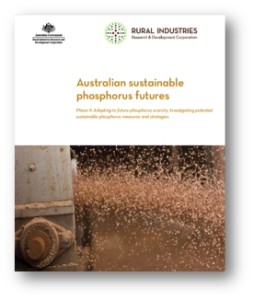
This RIRDC-funded project identified a range of factors influencing phosphorus supply and demand, and developed a framework for conceptualising and facilitating stakeholder dialogue on pathways on adapting to constrained phosphorus conditions and examining the economic, ecological, food security and rural livelihoods implications. National stakeholder workshop participants identified multiple pathways that could lead to phosphorus vulnerability in the Australian food system by exploring What if? scenarios (perturbations in the system). Potential adaptive pathways to increase the resilience of the food system (e.g. investing in phosphorus recycling from excreta and food waste or improved farm practices such as soil testing) were then mapped and trade-offs explored.
See Phase I and II Reports:
Cordell, D., Mikhailovich, N., Mohr, S., Jacobs, B. & White, S. (2014), Adapting to future phosphorus scarcity: investigating potential sustainable phosphorus measures and strategies, Phase II of the Australian Sustainable Phosphorus Futures project, prepared by Institute for Sustainable Futures, University of Technology Sydney, for the Rural Industries Research and Development Corporation, Australian Government, Canberra.
Cordell, D., Jackson, M., Boronyak, L., Cooper, C., Mohr, S., Moore, D. & White, S (2014), Analysis of phosphorus flows through the Australian food production and consumption system, Phase I of the Australian Sustainable Phosphorus Futures, Institute for Sustainable Futures, University of Technology Sydney, prepared for Rural Industries Research & Development Corporation, Australian Government, Canberra, pp.57.

